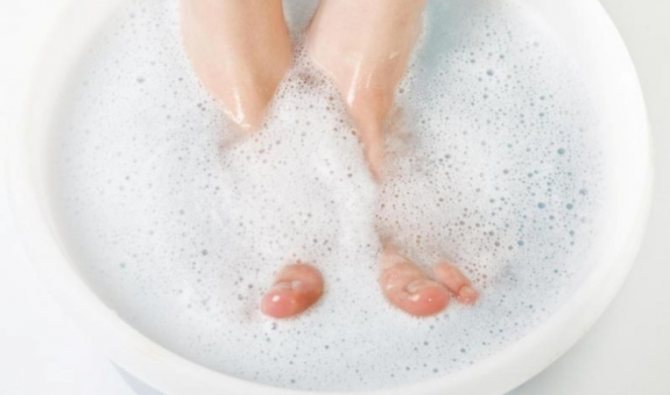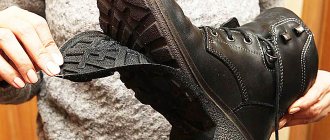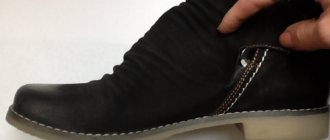Most people, with the arrival of autumn or spring, purchase new shoes and notice that when they take off the purchased boots or shoes, tights or socks have acquired an undesirable color. The reason for dyeing is that the dye transfers from leather products to the feet under the influence of heat and high humidity. If you are the owner of just such a product, then you need to know why shoes are painted from the inside and what to do in this case.
Causes of unwanted coloring
Many people think that dyed new things are of poor quality, however, this is not always the case.
New boots or shoes that stain the heel rather than the entire foot are often normal. For example, the product is made of suede, with a small insert inside, which is designed to prevent the boots from chafing while moving. In this case, moisture entering this insert causes the suede to begin to fade and stain the heel.
Often, manufacturers, trying to save money, use low-quality and cheap materials as insoles. Therefore, in order to avoid the question of what can be done to prevent shoes from being painted on the inside, it is recommended to purchase shoes with a light-colored insole. It doesn't stain the legs as much as dark material.
In addition to manufacturing defects, we can highlight other reasons for the staining of stockings from boots:
- while wearing the product, the wearing rules were not followed: the shoes periodically did not “rest” and regularly remained wet;
- The shoes are very old, the top of the insoles have worn off, resulting in the paint being exposed.
If the shoes stain the entire foot, then this means that they are made of poor quality material and are in fact defective.
How to choose shoes for the gym
Few people pay attention to choosing the right shoes for the gym. However, what you wear has a big impact on the safety and effectiveness of your workout. Therefore, special shoes for the gym are necessary.
How to choose the option that is right for you depends on the exercises you perform.
- Gym Shoes
To get not only loads, but also pleasure from training, you should choose the right shoes. All exercises can be divided into two large groups depending on the load: aerobic and strength. Therefore, you need to choose shoes that are equally suitable for both types of training.
Strength exercises involve the use of additional sports equipment, such as dumbbells or barbells. For such training, you need hard and stable shoes with durable soles that are thicker in the heel area. Such shoe parameters will provide you with stability, that is, they will reduce the risk of losing balance during training.
Aerobic exercise involves a lot of movement, so you'll need soft, lightweight, comfortable shoes that won't restrict your movement. It is also important that the shoes fit well and provide comfort. It is also necessary that the product has good breathability.
It turns out that you need durable, tough and at the same time light and breathable women's shoes for the gym. How to choose the right option?
Sports professionals advise buying sneakers that are suitable for training both in the gym and in the gym.
Shoe care rules
There are general rules for caring for shoes. Here are some recommendations that can prevent staining:
- Buy boots or shoes with thick insoles in a light color.
- Shoes should always be dried after wearing and shoes should never be worn when wet.
- If the problem is poor quality insoles, then replace them with better ones.
- Use shoe sprays; they create a slight film and prevent staining.
Following these simple rules will protect you from unpleasant emotions caused by unwanted coloring of stockings.
Ways to solve the problem
New shoes with the identified problem can be returned to the shoe store.
If you still have the sales receipt and the product is completely new, then you should receive a full refund. Remind the shoe store that, according to GOST, unstable dyeing during manufacturing is not allowed. That is, one way or another, the truth is completely on your side, and, if anything happens, the court will be able to prove it. But do not forget, in order to return a product, it must be unworn.
If you can’t get your money back, you can write a statement to the consumer rights service. After the application, the examination will make a decision: return your money for the shoes, or keep the product with you. The consumer must pay for this examination. The application must be accompanied by a payment receipt and documents for the shoes, which must be issued at the time of purchase.
Naturally, not all people will want to contact the consumer rights society for a pair of shoes or boots, but the seller, seeing such determination, may agree to return your money.
If you were unable to return your shoes because they are not entirely new, then you can try traditional methods.
Traditional methods
There are so-called grandmother’s or folk methods that have been used since ancient times. Despite the fact that these recommendations are as old as the hills, they are still popular due to their effectiveness.
- Vinegar. This is a great help in solving the problem of what to do if the shoes are painted on the inside. And everything is explained by the fact that acid is an excellent fixative. To use this product, you need to wet a sponge with vinegar and treat the product from the inside, then leave to dry. Airing your shoes outside will help remove the vinegar smell.
- Medical alcohol. This product can also help in treating shoes. To do this, moisten a sponge with medical alcohol and wipe the inside of the shoes. However, one important nuance must be taken into account: alcohol will not be able to fix the paint; on the contrary, it is a means that can simply wash it off.
- Hair fixation spray. Hairspray can help fix the paint on the sole; it can be purchased at any supermarket. You can also treat shoes with the product, but you must not forget that the varnish tends to wash off, and, accordingly, this method is not suitable for cloudy weather.
- Talc. This substance can also help solve the problem of what to do if the inside of shoes is painted. You can use regular starch instead of talc. The powder must be rubbed into the skin, and then carefully remove all excess.
- Burr oil. This product is also treated from the inside. You must wait until the substance is completely absorbed.
It must be remembered that any processing is carried out only in a completely dry state of the product, otherwise there will be no positive result from these efforts.
Modern means
On store shelves you can find modern products: AntiColor, StopColor.
They were developed by shoe manufacturers with customers in mind. Use paint fixatives only from well-known manufacturers, for example: Tarrago, Saphir, Salamander. With these tools you can solve the problem quite quickly. The easiest way to get rid of excess paint is to remove it using special products that artists usually use to clean brushes. By using this solution, you remove, rather than fix, the color pigments of the paint on the shoes.
Choose an odorless composition, otherwise after a certain time you will need to struggle with getting rid of the unpleasant “aroma”.
You can also put on old socks and walk around the apartment in new shoes, allowing the paint to transfer to them. Probably, after this procedure, the shoes will no longer stain the stockings or tights.
DEFECTS IN SHOES AND THE REASONS FOR THEIR APPEARANCE
According to the nature of the impact, all factors causing changes in the consumer properties of shoes are divided into:
Ø physico-chemical (humidity, temperature, light, oxygen);
Ø mechanical (impact, pressure, friction);
Ø biological (microorganisms - putrefactive bacteria, mold fungi; insects - moths, carpet beetles; rodents).
The consumer properties of goods, including shoes, can significantly deteriorate if there are defects.
A defect is a failure to fulfill a given or expected requirement regarding an object, as well as a failure to fulfill its consumer properties.
According to GOST 27438-87 “Footwear. Terms and definition of defects”, all known shoe defects can be presented in the form of a diagram (Fig. 1) [11].
Buyers, having discovered defects in shoes, contact the centers for examination and protection of consumer rights, which establish the causes and nature of the defects.
The consumer is interested in the end result, and not the process of making shoes; for manufacturers, the technology of shoe production is of greatest importance, and consumer opinions are often simply not taken into account.
Thus, manufacturing defects significantly affect the consumer properties of shoes and are a consequence of a violation of the technological process. This relationship is clearly presented in the form of a classification of defects (Fig. 2).
| · removable · irremovable |
| possibility of elimination |
| · pre-production · production · post-production |
| manufacturing stage |
| · hidden · obvious |
| manifestation during production and operation |
| · critical · significant · insignificant |
| significance |
| linear · areal |
| units |
| · strongly expressed · moderately expressed · weakly expressed |
| influence on properties |
| · single |
| isolated location |
| · defect in the appearance of shoes · functional |
| influence on aesthetic appearance or performance and functional properties |
| defect in shoe material |
| appearance of the material |
| · measurable · immeasurable |
| possibility of determination with a given accuracy |
Figure 1 Classification of shoe defects
| SHOES DEFECTS |
| Defects affecting reliability and functionality properties |
| Defects affecting ergonomic properties and safety |
| Post-production |
| Production |
| Material Defects |
| Pre-production |
| dimensional and complete |
| constructive |
| top |
| linings |
| bottom |
| plantar-attachment area |
| removable |
| fatal |
| workpiece assembly area |
| removable |
| fatal |
| molding area |
| cutting area and preparatory operations |
| storage |
| transportation |
| implementation |
| operation |
| Finishing defects |
| removable |
| fatal |
| Defects affecting aesthetic properties |
Figure 2 Relationship between defects and their impact on the properties of shoes
The causes of defects in shoes can be operational and production. Operational reasons may depend on the consumer (careless wearing of shoes, improper care) and/or on the enterprise producing the shoes (violation of manufacturing technology). Reasons depending on the enterprise can be hidden or obvious.
The production causes of defects may or may not depend on the enterprise. Reasons beyond the control of the enterprise are hidden and obvious defects in materials, if the enterprise does not produce them itself, but purchases them. This is clearly shown in Fig. 3
| REASONS FOR DEFECTS |
| Production |
| Operational |
| Production independent |
| Production dependent |
| Consumer dependent |
| Hidden |
| Explicit |
| Hidden |
| Explicit |
Figure 3 Causes of defects
Shoe defects for which returns are made, as well as the reasons for their occurrence at the production stage or during product operation [12] are presented in Table 1.
Table 1
Shoe defects
| External signs | Reasons for education |
| Fragrance of the upper leather | |
| When the skin is bent face inward at an angle of 90°, wrinkles appear that do not completely disappear after straightening the skin | Production - is formed as a result of a violation of leather production technology (excessive loosening of leather tissue during prolonged liming, excessive softening of the skin, intense tension of weakly or unevenly coated leather), as well as the use of lean raw materials |
Continuation of Table 1
| Ruffiness of the upper leather | |
| Folds and wrinkles in the form of furrows and ridges visible on the front side of the skin | Industrial - formed as a result of the proliferation of the epidermis and subcutaneous tissue. Occurs more often in leathers made from bull hides |
| Upper details of different leather densities | |
| The parts of the same name are unequal in thickness of the skin. Determined by bending the skin facing inwards | Production - formed as a result of the selection of parts of the same name, cut from different leathers or areas of leather |
| Snatches, undercuts of upper leather | |
| On the surface of the workpiece parts appear in the form of imprints of the damage contour from the side of the bahtarma | Production – formed as a result of damage (undercuts, snatches) of skins during shooting and processing it from the melon sides |
| Skin colors of different shades (vamps, butts, etc.) | |
| Uneven color shade of the same parts of the upper of the shoe | Production - (except for leathers coated with aniline type) - is formed as a result of poor preparation of leather for dyeing, the use of dyes of unsatisfactory quality, incorrect assembly of parts when cutting, uneven application of the finishing layer on the upper leather |
| Tackiness of upper leather coating | |
| Presence of sticky coating on the leather of the upper parts | Industrial - formed as a result of improper composition of leather coatings or violation of the drying regime |
Continuation of Table 1
| Matte finish of the varnish film of the upper leather | |
| Lack of shine or low shine of the varnish film on the leather of the upper parts | Industrial - formed as a result of an incorrect composition of the components of the varnish coating or a violation of the temperature conditions for drying shoes |
| Cracks in the varnish film of the upper leather | |
| The presence of cracks in the varnish coating on the leather of the upper parts: - while maintaining the elasticity of the leather - in the absence of elasticity of the leather in places of cracks | Production - formed as a result of excessive tension when tightening (molding) the workpiece onto the last and insufficient elasticity of the varnish film Non-production - formed as a result of violation of the operating conditions of the shoes (for example, drying at elevated temperatures, after significant wetness of the shoes) |
| Shedding of topcoat paint on the upper leather (fraying of finishing coating on the upper leather) | |
| Delay of the topcoat or finishing film from the surface of the leather, resulting in spots with a different shade of color | Industrial – formed as a result of improper preparation of the front surface of the leather before coating, violation of the coating formulation, violation of dyeing technology |
Continuation of Table 1
| Overgrown scars from damage to the facial layer of the upper skin | |
| Local various forms of distortion of the facial layer of the skin | Industrial - formed as a result of damage to animal skins by fistulas, ticks, ramie, sores, scabs, traces of smallpox, etc. |
| Upper leather face tie | |
| Local change in the natural measure in the form of wrinkles or small cracks | Industrial - formed as a result of strong binding of tanning agent caused by the high basicity of juices; rapid release of acid by the golem, insufficient pickling of the golem, increased temperature and astringency of the tannide solution. A similar defect in hard leathers is called brittleness. |
| Smudges and gaps in finishing on upper parts | |
| Visible unevenness or absence of finishing coating in certain areas of the skin | Industrial – formed as a result of non-compliance with coating technology |
| Instability and soiling of the dye of the upper or lining leather | |
| Dye instability, determined by the degree of dye transfer to white fabric with five times dry and wet friction on the surface of the skin | Industrial - formed as a result of a violation of the coating paint formulation, insufficient adhesion of the coating to the skin |
| Loops and weaves on the outer fabric | |
| Loops protruding from the surface of the fabric; several adjacent unintertwined threads | Industrial – formed as a result of a violation of fabric production technology |
Continuation of Table 1
| Bald spots, uneven lining pile height | |
| Lack of hair on the lining of natural fur. Uneven pile height in certain areas of lining pile fabrics | Industrial - is formed as a result of a violation of the primary preservation of hides, a violation of the processing technology of the semi-finished product. Violation of the operating mode of the shearing machine |
| Soles of different shades | |
| Uneven shade of soles in a pair | Production - formed as a result of incorrect selection of soles according to shade or violation of sole coating technology |
| Sole cracks | |
| Cracks of various depths and lengths without a change in the structure, color and hardness of the material Cracks of various depths and lengths with a violation of the structure, a change in color in the hardness of the material in places where cracks exist | Industrial - formed as a result of incorrect mixing and violation of sole production technology Non-industrial - formed during the use of shoes as a result of exposure to chemicals or drying shoes at high temperatures |
Continuation of Table 1
| Gaps between bottom parts or workpiece and bottom | |
| Visible gaps between the bottom parts, between the sole and the heel, between the heel and the heel of the shoe, affecting the quality | Manufacturing - is formed as a result of a violation of the technology of connecting individual parts of the bottom, fastening the bottom and finishing the parts of the bottom of the shoe |
| Irregularities on the surface of the sole or main insole | |
| Lumps, dents, protrusion of intermediate parts or the contour of the tightening edge, etc. | Production - formed as a result of the presence of defects in the bottom materials (shells, snatches, unequal thickness, etc.), violation of the technology for preparing the workpiece before fastening the bottom, violation of the technology for fastening the bottom |
| Thickening at the joints of parts | |
| Clearly defined bulges on the connection lines of workpiece parts, affecting quality | Production - formed as a result of incorrect descent of the edges of parts along the width, thickness and contour or a violation of the technology for connecting workpiece parts |
| Peeling off the folded edge of workpiece parts | |
| Areas where there is local or complete peeling off of the curved edge of the workpiece part | Production - is formed as a result of insufficient bending width of the edge of the part, lack of glue in the areas of the edge of the parts intended for bending, low adhesion of the glue, etc. |
| Incorrect perforation of parts | |
| Offsets, perforations that are not through or with unclean edges | Production - formed as a result of violation of the technology of perforating upper parts, the use of unsatisfactory quality leather on upper parts |
Continuation of Table 1
| Deviation from the symmetry of the arrangement of blocks, hooks, loops, buttons, rivets (holniten), buttons, decorative ornaments | |
| Displacement of the location points of blocks, hooks, loops, buttons, rivets (hollow threads), buttons and decorative ornaments relative to each other and the edge of the workpiece | Production – formed as a result of a violation of the technology for assembling a workpiece or molding shoes |
| Repeated stitching on the vamp, heel length ... mm | |
| Noticeable re-stitching or punctures in the first stitch, affecting quality | Production – formed as a result of a violation of stitch production technology |
| Falling of stitches from the edge (vamp, hem) with a length of ... mm | |
| Stitch falling off the edge of workpiece parts, lack of connection of parts in a certain area of the workpiece | Production – formed as a result of a violation of the technology of attaching (connecting) workpiece parts |
| Different length, height or width by ... mm of the same parts (vamps, socks, ankle boots, etc.) | |
| Discrepancy between the length, height and width of the same parts (vamps, socks, ankle boots, etc.) between half-pairs | Production – formed as a result of a violation of the technology for selecting workpiece parts, molding the workpiece, or attaching the bottom of shoes |
Continuation of Table 1
| Skipping stitches of stitching (edging, vamp, etc.) with a length of ... mm | |
| Missed stitches, loose threads, punctures without thread placement | Production – formed as a result of a violation of stitch production technology |
| Rupture of the skin (material) of the workpiece | |
| Visible tear of various shapes and sizes: - without deformation of the upper at the site of the tear - with deformation of the upper (elongation, convexity of the skin of the workpiece due to the structural features of the foot, etc.) | Production - formed as a result of the use of low quality material, violation of the workpiece assembly technology (excessive descent of the edges of parts, frequent stitching, etc.) Non-production - formed as a result of excessive physical impact; due to the structure of a person’s foot or gait |
| Destruction of the stitching of parts | |
| Breakage of threads in certain sections of the stitching Presence of thread residues with smooth edges in punctures, presence of stitching destruction, damage to the upper material, deformation of the part along the line of stitching destruction | Production - formed as a result of low quality threads, violation of stitch production technology Non-production - formed as a result of mechanical damage or excessive physical impact during operation |
Continuation of Table 1
| Deviation of the back seam or back outer strap from the center line of the heel area | |
| Displacement of the longitudinal axis of the rear seam or rear outer strap from the center line of the heel area | Production – formed as a result of a violation of the technology of molding the heel of the shoe |
| Cracks or tears in the leather (material) perpendicular to the edge | |
| Visible cracks or tears of different lengths: - without sharp deformation or excessive elongation of the upper material - with deformation of the shoe and elongation of the upper material | Industrial - formed as a result of excessive thinning of the edge of the upper, the absence or poor quality of reinforcing tape Non-industrial - formed as a result of excessive physical or mechanical stress due to a discrepancy between the fullness of the shoe and the fullness of the foot |
| Folds of the lining (vamp, ankle boots, etc.) | |
| Folds or wrinkles, lining affecting quality | Production - formed as a result of violation of the molding technology of the workpiece, the use of low quality lining leather |
Continuation of Table 1
| Wrinkling or folding of the upper leather (vamp, heel, etc.) | |
| Folds or wrinkles of the upper material: - without changing the shape of parts, structure and elasticity of the upper material and coating, etc. - with changes in the shape of parts and structure of the upper material | Production - formed as a result of improper cutting of material into parts, violation of shoe molding technology Non-production - formed as a result of excessive physical impact, due to a discrepancy between the fullness of the shoe and the fullness of the foot, structural features of the foot |
| Alignment of intermediate parts on the vamp, heel, etc. | |
| The edge of the contour of the heel, toe cap and other intermediate parts visible on the shoe upper blank | Production - formed as a result of a violation of the technology of molding the toe and heel |
| Different shaped heel and toe parts of shoes between half-pairs | |
| The toe and heel parts of shoes of one half-pair do not correspond in shape to the other half-pair | Production – formed as a result of a violation of the technology of molding the toe and heel parts of shoes (unmolded toe and heel parts) |
Continuation of Table 1
| Overhang of the shoe upper blank over the edge of the sole in the heel, beam, and toe parts | |
| The shoe upper blank hangs over the sole: - without changing the original shape of the shoe - with a sharp change in the original shape of the shoe | Manufacturing - is formed as a result of a discrepancy between the contour of the workpiece footprint and the contour of the sole, thickening of parts due to the use of a main insole that does not correspond to the footprint of the last. Non-productive - formed as a result of incorrect selection of shoes for the foot |
| Toe caps and heels of different rigidity and elasticity between half-pairs | |
| The difference in the rigidity and elasticity of the socks and heels between half-pairs in a pair is noticeable when touched with your fingers. | Production - formed as a result of a violation of the technology of molding the toe and heel |
| Incorrect ruffling of the drawstring edge of the vamp, heel | |
| Ruffling of the protracted edge of the workpiece above the edge of the sole, insufficient or too deep | Production – formed as a result of a violation of the technological process of preparing the tightening edge for the operation of gluing the sole, inaccurate installation of the sole along the contour of the track |
| Significant deviation of the lower heel platform from the horizontal surface of the support | |
| Displacement of the heel relative to the vertical axis, non-adhesion of the bottom of the heel to the horizontal surface of the support | Displacement of the heel relative to the vertical axis, non-adhesion of the bottom of the heel to the horizontal surface of the support |
Continuation of Table 1
| Heel subsidence, toe cap | |
| The upper part of the shoe hangs over the edge of the sole or heel: - the toe cap (heel) at the base is soft, losing its shape. The shoes have retained their original shape - the toe box, the heel at the base is quite rigid and shape-resistant. Shoes are significantly expanded compared to the original shape or have mechanical damage to the upper leather in places of subsidence m HDhIF2g20nbyXt7Ep5Mj6fHcS/uD6e9OMyy3pPZJO4N Z9HRIDvMJpMseueYR3FSsaKgwpG/34Io/rsp6/ZxO7+7PdiVKdhH9/UEsve/nrSfAdf27QDNZbE+ 1y47Nw4w+N64W1K3Wb/evdX DX8n4JwAAAP//AwBQSwMEFAAGAAgAAAAhAJgOR4nhAAAACwEAAA8A AABkcnMvZG93bnJldi54bWxMj0FPg0AQhe8m/ofNmHgxdtdCsCBLY0hM9GJSNMbjFkYgZWeR3Rb8 946nepz3Xt58L98udhAnn HzvSMPdSoFAql3TU6vh /e3pdgPCB0ONGRyhhh/0sC0uL3KTNW6mHZ6q 0AouIZ8ZDV0IYyalrzu0xq/ciMTel5usCXxOrWwmM3O5HeRaqURa0xN/6MyIZYf1oTpaDYey2s33 ZRJ/f96412f50ZYvm1nr66vl8QFEwCW cw/CHz+hQMNPeHanxYtAQrWPeEthIVASCE1EaxSD2rKSp Alnk8v+G4hcAAP//AwBQSwECLQAUAAYACAAAACEAtoM4kv4AAADhAQAAEwAAAAAAAAAAAAAAAAAA AAAAW0NvbnRlbnRfVHlwZXNdLnhtbFBLAQItABQABgAIAAAAIQA4 /SH/1gAAAJQBAAALAAAAAAAA AAAAAAAAAC8BAABfcmVscy8ucmVsc1BLAQItABQABgAIAAAAIQD2eIr/cAIAAJIEAAAOAAAAAAAAA AAAAAAAAAC4CAABkcnMvZTJvRG9jLnhtbFBLAQItABQABgAIAAAAIQCYDkeJ4QAAAAsBAAAPAAAA AAAAAAAAAAAMoEAABkcnMv ZG93bnJldi54bWxQSwUGAAAAAAQABADzAAAA2AUAAAAAA » strokeweight=»1.75pt»> | Production - formed as a result of a violation of the technology of molding the toe (heel) of shoes Non-production - formed as a result of incorrect selection of shoes according to the fullness of the foot or mechanical damage to shoes during use |
| Peeling off of the sole in the beam, toe, etc. parts | |
| Areas where there is a non-glued sole. Local (or complete) lag of the sole from the tightening edge along the adhesive seam | Production - formed as a result of improper processing of the tightening edge, lack of adhesive film in certain areas, violation of the sole gluing technology |
Continuation of Table 1
| Destruction of the adhesive seam securing the sole | |
| Local lag of the sole from the tightening edge. The edge of the sole and the main insole in the place of lag is deformed in the form of a bend, part of the lingering edge is on the sole and is firmly held. The sole in adjacent areas is firmly glued | Non-productive – formed as a result of mechanical damage to shoes during use |
| Incorrect fastening (termination) of the welt, outline | |
| Visible cleft between the connected ends of the welt, edge | Production - formed as a result of unclear use of technology for fastening the welt, edging |
| Peeling off the undercut sole | |
| Sole trim areas where sole attachment stitches are visible | Industrial – formed as a result of a violation of the technology for closing the sole trim |
| Incorrect heel installation | |
| Displacement of the heel relative to the axis or center of the heel part of the shoe and discrepancy between the contour of the heel and the contour of the sole in the heel part | Manufacturing – formed as a result of improper installation of the heel |
| Cracks in the leather of the shoe upper | |
| Presence of cracks on the top of the skin | Production - formed as a result of low quality leather on the upper of the workpiece or a violation of shoe production technology |
Continuation of Table 1
| Damage to the leather (material) of the top of the back, etc. in the form of abrasion | |
| The presence of damage on the skin (material) | Production failure of new shoes due to unsatisfactory packaging of the shoes by the manufacturer. Detected during the period of checking the number of shoes Non-production - formed as a result of mechanical damage to shoes during sales or operation |
| Heel heel sagging, falling out or tearing off | |
| Cracks between the heel and the bottom of the heel or its separation: - without mechanical damage with mechanical damage - with mechanical damage on the heel or heel cover | Production - formed as a result of a violation of the heel fastening technology Non-production - formed as a result of mechanical damage during operation |
| Heel lag | |
| A visible gap between the heel and the heel that occurs when the heel is pressed with the thumb | Production – formed as a result of incorrect installation of the heel or violation of the technology for fastening it |
Continuation of Table 1
| Heel separation | |
| The heel is torn from the heel part: - the heel fastening does not provide grip strength - the heel fastening ensures grip strength, but there is mechanical damage to the heel cover | Production - formed as a result of an insufficient number of fasteners or their insufficient length Non-production - formed as a result of mechanical damage that contributes to the heel coming off |
| Heel fracture or split | |
| Fracture or cracks of a heel of varying depth: - the heel or heel does not have additional production fasteners - the heel or heel has additional non-manufacturing fasteners or mechanical damage that contributes to the formation of a defect | Production - formed as a result of a violation of the manufacturing technology of the heel or its fastening Non-production - formed as a result of poor-quality shoe repair or mechanical damage |
Continuation of Table 1
| Heel fracture or split | |
| Fracture or cracks of a heel of varying depth: - the heel or heel does not have additional production fasteners - the heel or heel has additional non-manufacturing fasteners or mechanical damage that contributes to the formation of a defect | Production - formed as a result of a violation of the manufacturing technology of the heel or its fastening Non-production - formed as a result of poor-quality shoe repair or mechanical damage |
| Damage to the skin (material) of the top of the vamp, heel, etc. in the form of scratches, cuts, abrasions, etc. | |
| The presence of scratches, cuts, abrasions and other damage on the leather (material) of the upper with or without traces of industrial repair, affecting the quality of the shoes | Manufacturing in new shoes without traces of fitting (contamination or abrasion of the running surface of the sole, main or insole, lining, deformation of the upper) is formed as a result of a violation of the shoe production technology. Non-manufacturing in new shoes with traces of fitting and in worn ones is formed as a result of mechanical damage to the shoe. in the process of trying on and using shoes |
Continuation of Table 1
| Faulty zipper | |
| — Rupture of the textile tape along the line of stitching or fastening links; the zipper lock does not move, the zipper links do not connect, spontaneous separation of the zipper links" - without sharp deformation of the top of the boots (tops) - in the presence of a sharp deformation or excessive elongation of the tops of the boots (tops) | Industrial - formed as a result of poor quality zippers or a violation of the technology of its fastening Non-industrial - formed as a result of excessive physical impact, due to the discrepancy between the width of the boot tops and the volume of the leg or lower leg |
| Damage to the skin (material) of the top of the vamp, heel, etc. in the form of scratches, cuts, abrasions, etc. | |
| The presence of scratches, cuts, abrasions and other damage on the leather (material) of the upper with or without traces of industrial repair, affecting the quality of the shoes | Manufacturing in new shoes without traces of fitting (contamination or abrasion of the running surface of the sole, main or insole, lining, deformation of the upper) is formed as a result of a violation of the shoe production technology. Non-manufacturing in new shoes with traces of fitting and in worn ones is formed as a result of mechanical damage to the shoe. in the process of trying on and using shoes |
Continuation of Table 1
| The lining does not fit under the tightening | |
| The presence of a free edge of the lining that was not caught under the tightening | Production - formed as a result of insufficient length of the tightening edge of the lining, a violation of the technological process of molding the shoe upper blank |
A study of shoe returns shows that the largest share is due to reasons that depend directly on the manufacturers. Therefore, in the competition for consumers, enterprises that will pay due attention to quality issues, increase the level of production and take into account the wishes of consumers in the field of shoe quality will win.
Bibliography
1. Ivanov M.N. etc. Commodity research of footwear goods. - M.: Economics, 1990, 363 p.
2. I.I.Mazur, V.D.Shapiro. Quality management: textbook. manual for university students. – 3rd ed. – M.: Omega-L Publishing House, 2006. – 400 p.
3. KISa: step ten - QUALITY and MANAGEMENT. www.quality.eup.ru/DOCUM/kisa10.html, 2003
4. GOST 28371-89 “Footwear. Determination of grade."- M., 1989.-4p.
5. https://www.leathernet.ru/doc1.php
6. GOST 26165-2003 “Children’s footwear. General technical conditions." - M.: IPK Standards Publishing House, 2004.-10 p.
7. GOST 26167-2005 “Casual footwear. General technical conditions." - M.: FSUE TsNIIKP, 2005.-15 p.
8. GOST 19116-2005 “Design footwear. General technical conditions."-M.: Standartinform, 2007.-8p.
9. GOST 1135-2005 “Household and road footwear. General technical conditions."-M.: Standartinform, 2006.-11p.
10. Law of the Russian Federation “On the Protection of Consumer Rights” https://www.consultant.ru/popular/consumerism/
11. Antimonova I.N. Regulating the technological process to ensure the quality of footwear. Abstract of dissertation for candidate of technical sciences..-M., 2008.-24 p.
12. GOST 27438-87 (ST SEV 5787-86). Terms and definitions of vices. M.: Standards Publishing House, 1991.-15 p.
13. Vasiliev V.A. and others. Commercial merchandising and examination: Textbook for universities. - M.: Banks and exchanges, UNITY, 1997, 135 p.
2
The process of getting rid of paint on legs
If, after all, your feet have acquired an unnatural color from the leather on your shoes, then do not worry. There are a large number of ways that can help solve the problem:
- Treat your toes and heels with a foot file or pumice stone.
- Wash your heel with warm water and soap.
- Treat stained areas of your feet with nail polish remover or alcohol.
After the manipulations, be sure to lubricate your feet with cream.
To prevent problems with dyeing hosiery items from appearing, you can listen to certain recommendations.
Preventive measures
If your feet sweat a lot, you can purchase special medical products.
They can help get rid of excessive sweating, and the problem with skin coloring will also be solved. Try not to let your shoes get into water frequently, especially when you know that the product you purchased stains your feet; you should not wear these shoes in cloudy weather.
Compositions for processing leather products must be purchased only of high quality. There is no need to skimp so as not to regret it in the future.
Naturally, it is quite ugly and unpleasant if the shoes begin to stain the stockings. However, there is no need to worry about this. Any person can cope with this trifle. Choose only high-quality shoes that will certainly please your feet.
Recommendations for preventing staining
To avoid paint on your feet or clothes from shoes, you should adhere to the following recommendations:
- If your feet sweat a lot, use special pharmaceutical products that are aimed at reducing the intensity of sweating. This will help not only from the appearance of paint, but also get rid of the unpleasant smell of shoes.
- Avoid getting wet. If the boots are painted, it is better not to wear them in rainy weather.
- When choosing care products, give preference to proven products. They may cost more, but you will be confident that the shoes will last a long time.
- Treat the inside of the shoes with a special spray (“Anticolor” or “Stopcolor”).










